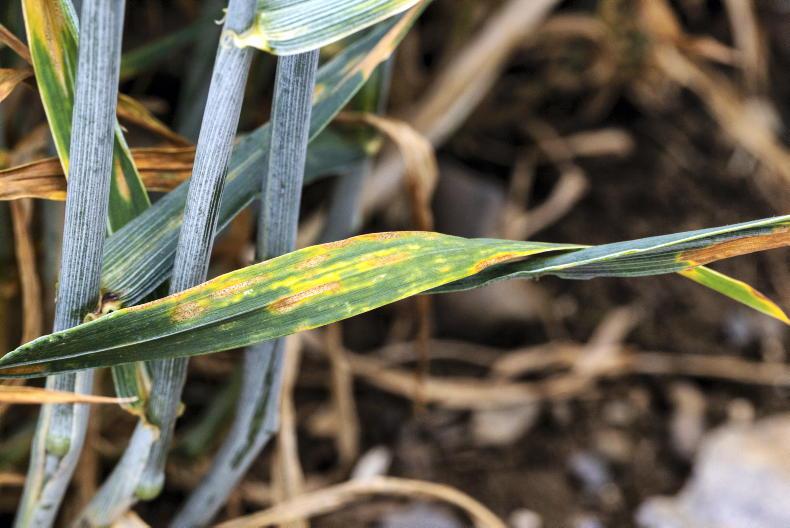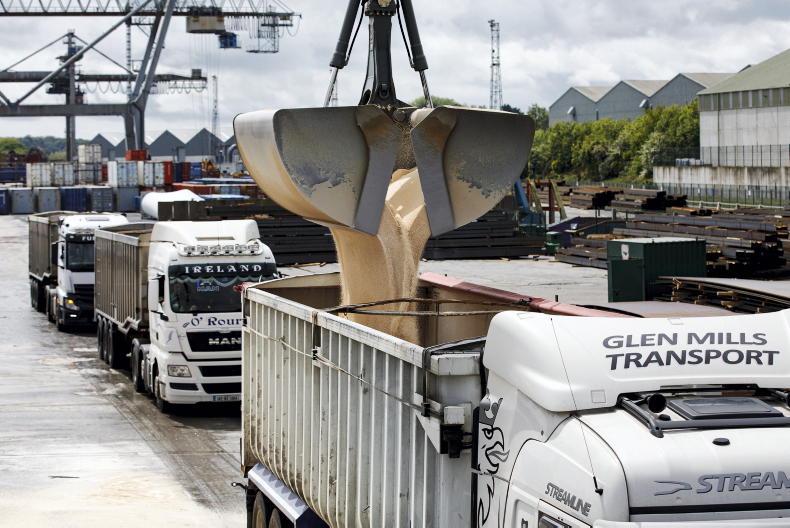A survey of attendees at Tillage Day found that 51% of farmers forward sell grain.
Despite this, James Nolan of R&H Hall told attendees that not many farmers sold grain when prices were at their highest in May of this year.
He explained that much of this is down to psychology and people do not want to sell into a rising market. However, the market eventually falls again and the high prices can be missed out on.
He also noted that a lot of 2022 grain was sold earlier this year when prices were low. Growers had held onto the grain hoping that prices would keep rising.
When the markets fell, they stored the grain for 18 months, but eventually sold it earlier this year, even though prices were not very high.
Donal Moloney of Tirlán said that some farmers will forward sell every year, while others won’t touch it. He explained that farmers who are not experienced with forward selling grain disengage with the process if they get caught out in a certain year, even if they benefit from it in another.
Of those that don’t forward sell grain, 43% worried that there would be a higher price at harvest, 41% don’t know what price to sell at, and 16% think it’s too risky.
Rory Deverell of Black Silo Commodity Consulting commented that prices could rise at harvest after forward selling, but history has shown that this will only happen once every six or seven years.
His comments were reflected by those who do forward sell grain, where 41% of farmers forward sell to manage risk and think it is too risky to sell all of their grain at harvest; 35% sell grain at a price they know they can make a profit at, and 24% store their grain and sell it throughout the year when the price is right.
Top tips for forward selling grain
1 Know your costs of production
All three panellists agreed that this is the most important step when deciding to forward sell grain.
Farmers must know how much each hectare of grain is costing to grow and a conservative estimate of yield, then a cost/tonne can be calculated.
This will give farmers a figure at which to start and decide how much over the cost of production they are happy to sell at.
2 Consider grain prices
Finding out the current grain prices and what your local merchant is offering is essential.
Donal Moloney said that Tirlán text their suppliers a green and dry grain price once a week, so farmers are kept up to date with the price at which they can forward sell.
Aside from the Irish Farmers Journal Grain Trends report each week, Noggers Blog and the AHDB website were recommended as good places for farmers to start viewing current grain prices and market trends.
3 Decide when and how much to sell
The main aim of forward selling is to sell at a margin. Once the cost of production and current grain price is known, farmers can spread their grain sales over a period of time to achieve this.
James Nolan noted that forward selling is not all about price, it can be about cash flow and can potentially reduce stress. The advice on the day was to sell little and often, perhaps 10% at a time.
Rory Deverell warned farmers to never sell grain that they might not have at harvest. Donal Moloney said that while there is no minimum amount of grain that can be forward sold, merchants would like at least 20 tonnes for a contract.
4 Don’t think of what could have been
After a farmer sells grain, the price may rise. However, it must be remembered that they were happy to sell the grain at the agreed price.
Benefits will not be realised every single time a farmer forward sells, but it can reduce risk and be beneficial over the long term.
Managing risk through minimum pricing
A relatively new opportunity for growers regarding grain trading is that of grain options and minimum price trading. Rory Deverell is one person who is bringing this to Irish growers.
Rory made the point that forward selling 20% of your grain does not help much if the price falls, and it reduces the potential gains if prices rise.
As a grain trader and farmer, he began looking at ways to improve the return for his own farm and for his clients.
“I transformed the whole thinking so that I can create a minimum price for our farm. We’ve never looked back,” he said. “It’s based around using MATIF and the insurance market on that.”
Once a farmer knows their cost of production and what price they are willing to sell at, they can lock into the price the market is at. If the grain price falls, they will be protected and will receive the agreed price.
However, if grain markets rise, they will receive the higher price, similar to a price insurance.
“It can make it safer and more profitable to grow crops here,” said Rory. At Tillage Day, David Hobson, a farmer from Meath, joined the panel to speak about his experience of using this system with Rory.
“The big thing for us was to get a handle on our overheads, our inputs, and our five-year yields.
The next thing was to see what was our acceptable minimum margin per tonne. When you have these two things, you can start to set target prices.”
David added that the cost of taking out the option is your insurance premium. “Once you have your minimum price that you’re comfortable with, it gives you massive peace of mind.
If the grain price falls, the value of your option increases.”
David admits that it was daunting at the start, but it has become a “no-brainer” for his farm.
A survey of attendees at Tillage Day found that 51% of farmers forward sell grain.
Despite this, James Nolan of R&H Hall told attendees that not many farmers sold grain when prices were at their highest in May of this year.
He explained that much of this is down to psychology and people do not want to sell into a rising market. However, the market eventually falls again and the high prices can be missed out on.
He also noted that a lot of 2022 grain was sold earlier this year when prices were low. Growers had held onto the grain hoping that prices would keep rising.
When the markets fell, they stored the grain for 18 months, but eventually sold it earlier this year, even though prices were not very high.
Donal Moloney of Tirlán said that some farmers will forward sell every year, while others won’t touch it. He explained that farmers who are not experienced with forward selling grain disengage with the process if they get caught out in a certain year, even if they benefit from it in another.
Of those that don’t forward sell grain, 43% worried that there would be a higher price at harvest, 41% don’t know what price to sell at, and 16% think it’s too risky.
Rory Deverell of Black Silo Commodity Consulting commented that prices could rise at harvest after forward selling, but history has shown that this will only happen once every six or seven years.
His comments were reflected by those who do forward sell grain, where 41% of farmers forward sell to manage risk and think it is too risky to sell all of their grain at harvest; 35% sell grain at a price they know they can make a profit at, and 24% store their grain and sell it throughout the year when the price is right.
Top tips for forward selling grain
1 Know your costs of production
All three panellists agreed that this is the most important step when deciding to forward sell grain.
Farmers must know how much each hectare of grain is costing to grow and a conservative estimate of yield, then a cost/tonne can be calculated.
This will give farmers a figure at which to start and decide how much over the cost of production they are happy to sell at.
2 Consider grain prices
Finding out the current grain prices and what your local merchant is offering is essential.
Donal Moloney said that Tirlán text their suppliers a green and dry grain price once a week, so farmers are kept up to date with the price at which they can forward sell.
Aside from the Irish Farmers Journal Grain Trends report each week, Noggers Blog and the AHDB website were recommended as good places for farmers to start viewing current grain prices and market trends.
3 Decide when and how much to sell
The main aim of forward selling is to sell at a margin. Once the cost of production and current grain price is known, farmers can spread their grain sales over a period of time to achieve this.
James Nolan noted that forward selling is not all about price, it can be about cash flow and can potentially reduce stress. The advice on the day was to sell little and often, perhaps 10% at a time.
Rory Deverell warned farmers to never sell grain that they might not have at harvest. Donal Moloney said that while there is no minimum amount of grain that can be forward sold, merchants would like at least 20 tonnes for a contract.
4 Don’t think of what could have been
After a farmer sells grain, the price may rise. However, it must be remembered that they were happy to sell the grain at the agreed price.
Benefits will not be realised every single time a farmer forward sells, but it can reduce risk and be beneficial over the long term.
Managing risk through minimum pricing
A relatively new opportunity for growers regarding grain trading is that of grain options and minimum price trading. Rory Deverell is one person who is bringing this to Irish growers.
Rory made the point that forward selling 20% of your grain does not help much if the price falls, and it reduces the potential gains if prices rise.
As a grain trader and farmer, he began looking at ways to improve the return for his own farm and for his clients.
“I transformed the whole thinking so that I can create a minimum price for our farm. We’ve never looked back,” he said. “It’s based around using MATIF and the insurance market on that.”
Once a farmer knows their cost of production and what price they are willing to sell at, they can lock into the price the market is at. If the grain price falls, they will be protected and will receive the agreed price.
However, if grain markets rise, they will receive the higher price, similar to a price insurance.
“It can make it safer and more profitable to grow crops here,” said Rory. At Tillage Day, David Hobson, a farmer from Meath, joined the panel to speak about his experience of using this system with Rory.
“The big thing for us was to get a handle on our overheads, our inputs, and our five-year yields.
The next thing was to see what was our acceptable minimum margin per tonne. When you have these two things, you can start to set target prices.”
David added that the cost of taking out the option is your insurance premium. “Once you have your minimum price that you’re comfortable with, it gives you massive peace of mind.
If the grain price falls, the value of your option increases.”
David admits that it was daunting at the start, but it has become a “no-brainer” for his farm.









SHARING OPTIONS